Split Shot Rig 101 (Setup and Fishing Guide with Pictures)
PUBLISHED 16 AUGUST 2023
by Robert Ceran
Are you planning to throw a split shot rig, but aren’t sure how to set it up, or how to fish it for optimal results?
While the split shot rig is without a doubt one of the best finesse fishing rigs that catches a wide range of fish species, it can be tricky to set up and to fish it for the best results.
In this article I’ll show you how to set up a split shot rig, and will aso cover what bait to use with it, and how to use it to put more fish in the boat.
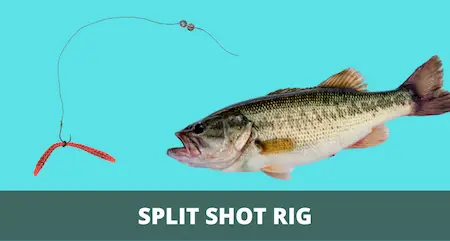
What is a split shot rig (and what is it good for)?
A split shot rig (also known as mojo rig) is a finesse fishing setup that’s primarily used for bass fishing with soft plastics, and is particularly effective for targeting pressured bass or finicky biters.
However, the split shot also works well for anglers targeting other fish species, including trout, crappie, walleye, and perch.
And while the split shot rig is a type of bottom fishing rig, it works best in shallow water, as a split-shot sinks too slowly to fish effectively in deep water. It is also best suited for fishing at close distance because the split shot weights aren’t heavy enough to allow for long casting.

Due to its lightness of weight, a split-shot setup sinks slowly in the water column, and hence has to be fished slowly. This fishing technique is perfect for catching finicky bass, which prefer more subtle presentations and slower lure action.
Split shot rig components
You’ll need the following tackle components to set up a split shot rig:
- Split shot weights (also called clamp-on weights)
- 6 to 12 lb test monofilament main line
- Size 2/0 to #4 hook
- Soft plastic bait of your choice
- Spinning rod and reel setup
- 4 to 6 lb test fluorocarbon leader (optional)
- Swivel (optional)
If you’re using monofilament as your main line, you don’t need to tie a leader. But if you’re using braid as your main line, you may want to use a fluorocarbon leader, since that comes with more stealth in the water, as it is harder for fish to spot.
And if you do opt for rigging a leader, use the swivel to connect your main line to the leader.
How to tie a split shot rig
A simple split shot rig is one of the most basic fishing rigs that you can imagine. It simply consists of a hook tied to your main fishing line with a uni knot, and several split shot sinkers pinched onto the line with pliers about 1 to 3 feet above the hook.
The hook is then baited with a soft plastic bait, and you’re ready to fish. However, with that being said, there are many additional nuances that can affect your success with split-shot fishing.
For one thing, if you’re using braided fishing line as your main line, it’s better to tie a monofilament or fluorocarbon leader for the last 1 to 3 feet of your line, since that is less likely to spook shy fish.
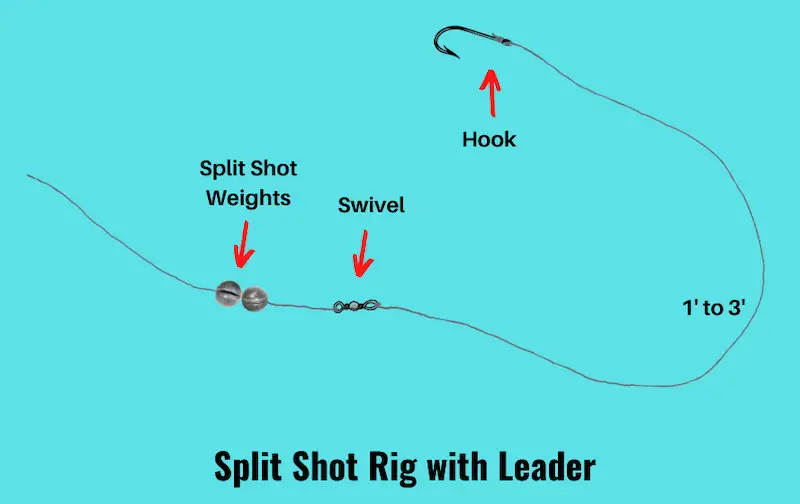
Secondly, your choice of hook is also very important. If you’re planning to fish with soft paddle tail swimbaits or plastic worms, a great option is to use a worm hook, or an extra wide gap hook.
If you’re using natural bait or live bait (as is often used for trout fishing with a split shot), a better option is to use an octopus hook or a J-hook.
Finally, if you’re planning to wacky rig your worm, it’s best to use wacky hooks.
Choosing the right leader length
The ideal leader length for a split shot rig depends on how fast you want your bait to react to your rod. Keep in mind that when you twitch your rod tip, this initially moves the split shot weights, and then the plastic bait follows with a slight delay.
The shorter the leader line, the quicker the plastic bait will react to your rod movements, while a long leader will lead to a delayed reaction of the bait.
However, a longer leader can also be helpful when dealing with finicky fish and shy biters, as it makes it less likely that they will spot the weights attached to your line.
When in doubt, start with an 18 inch leader, and then experiment with shortening it or extending it, until you get the desired results.
The nice thing about clamp-on weights is that you can often slide them slowly up or down the line, if you didn’t clamp them too tightly.
What bait should you use with a split-shot rig?
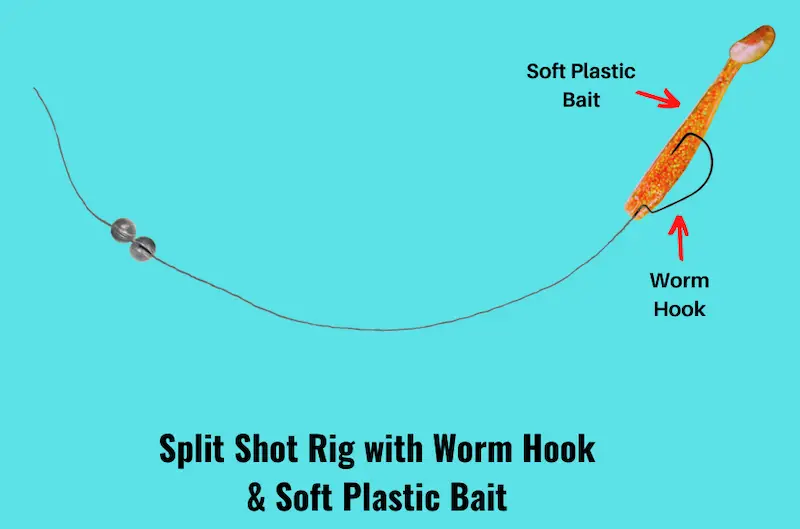
If you’re a fisherman planning to target bass with a split shot, the best bait to use with it is a soft plastic worm or swimbait.
With that being said, there is an almost infinite variety of soft plastics that you can choose from, including straight tail worms, paddle tail worms, ribbon tail worms, paddle tail swimbaits, and U tail worms.
Another great option is to wacky rig a plastic worm to your hook when using a split-shot rig, as that sinks down even slower in the water, and this can be deadly for triggering bites from bass in shallow water.
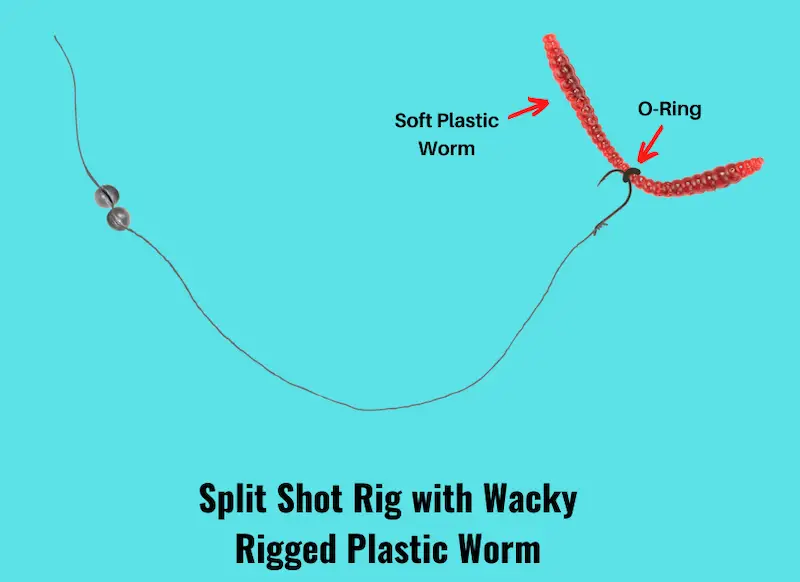
Since soft plastics are cheap, I recommend that every angler should get a wide variety of them, and test as many as possible until a clear winner emerges.
How to fish a split shot rig
While a split shot setup is sometimes compared to the Carolina rig, it is much more lightweight, and unlike the Carolina fishing rig, it can’t be cast over long distances,
Because of this, it’s best to use the split-shot for fishing at close quarters around docks, laydowns, sunken timber, or the edges of grass beds.
After casting it out, let the split shot slowly sink to the bottom, and then retrieve it by jigging it slowly, and interspersed with long breaks where you let it sink again.
Also, since it is such a light rig, it’s best to use an ultralight spinning rod and reel for throwing it, as that will not only result in better casting distances, but will also give you that extra sensitivity to feel subtle bites.
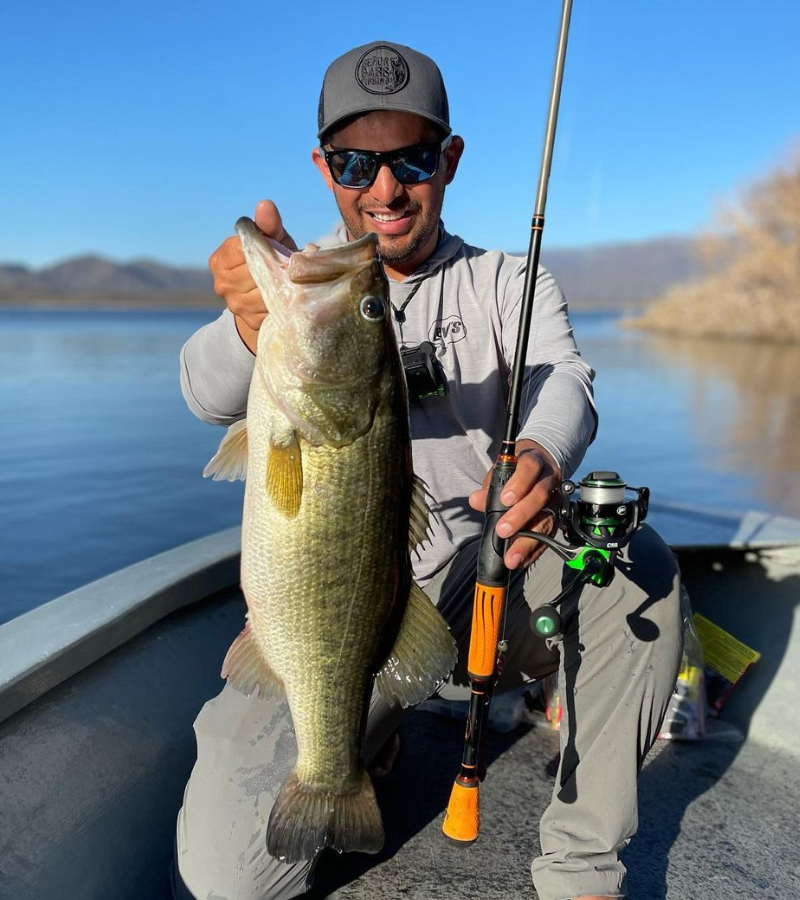
Image source: instagram/@senorbassfishing
It can be hard to detect bites when fishing with a split-shot, since you often don’t feel much of a tug when a fish “inhales” your plastic worm. That’s why you have to pay attention to every single vibration of the line that you can feel through the blank of your rod.
Also pay attention to the line going slack, which can signal that a bass has grabbed the bait, and is swimming with it.
When targeting trout with a split shot rig in streams and rivers, drift your rig with the current along current breaks and trout feeding lanes under overhanging bushes and trees.
